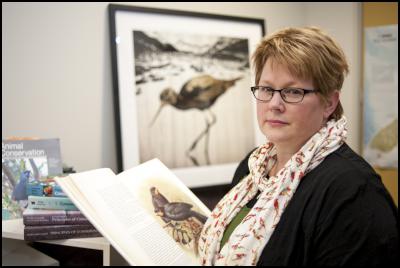No, you can’t have a moa - resurrecting extinct species?
No, you can’t have a moa - the risks of resurrecting extinct species explored

Can the huia escape the re-extinction vortex?
The perils of resurrecting extinct species, such as the moa or huia, will be discussed when a new paper, led by University of Canterbury (UC) conservation geneticist Dr Tammy Steeves, is published in international journal Functional Ecology this week.
The paper, written for a special feature on the ‘Ecology of De-extinction’, by Dr Steeves of UC’s School of Biological Sciences, along with Associate Professor Jeff Johnson, University of North Texas, and UC conservation geneticist Dr Marie Hale, highlights the perils of resurrecting species using only a few, genetically similar individuals.
“Simply put, the more genetic diversity a species has, the more likely it is that it will be able to adapt to a changing environment. Plus the more individuals a species has, the less likely it is to randomly lose genetic diversity over time,” Dr Steeves says.
The Senior Lecturer in Conservation and Evolutionary Genetics says it is vital to consider evolutionary potential – the ability a species has to adapt to environmental change.
“Small populations that lack genetic diversity are in danger of spiraling to the point of re-extinction. This scenario is called the re-extinction vortex.”
One of the key points considered in the journal’s special feature is that long extinct species, such as moa, are poor candidates for resurrection. More recently extinct species, such as the huia, may be better resurrection candidates. Aotearoa New Zealand’s largest wattlebird, the huia was made extinct in the early 20th century due to a combination of factors, including over-hunting for natural history collections and a fashion craze for its feathers.
Dr Steeves is not an advocate for or against de-extinction and she emphasises that meaningful conversations about resurrecting extinct treasured species will need to include relevant indigenous communities such as Māori iwi, rūnanga or hapū.
Maximising evolutionary potential in functional proxies for extinct species: a conservation genetic perspective on de-extinction by Tammy Steeves (University of Canterbury) et al.


 Business Canterbury: Urges Council To Cut Costs, Not Ambition For City
Business Canterbury: Urges Council To Cut Costs, Not Ambition For City Wellington Airport: On Track For Net Zero Emissions By 2028
Wellington Airport: On Track For Net Zero Emissions By 2028 Landcare Research: ANZAC Gall Fly Release Promises Natural Solution To Weed Threat
Landcare Research: ANZAC Gall Fly Release Promises Natural Solution To Weed Threat NZ Anti-Vivisection Society: Auckland Rat Lovers Unite!
NZ Anti-Vivisection Society: Auckland Rat Lovers Unite! University of Canterbury: $1.35 Million Grant To Study Lion-like Jumping Spiders
University of Canterbury: $1.35 Million Grant To Study Lion-like Jumping Spiders Federated Farmers: Government Ends War On Farming
Federated Farmers: Government Ends War On Farming



